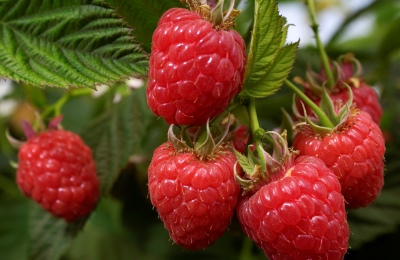
- Repairability: Yes
- Berry color: ruby
- Taste: sweet and sour
- Ripening period: late
- Berry weight, g: 2,7 - 3,5
- Yield: up to 1.5-2.0 kg per bush, 8-9 t / ha
- Frost resistance: above average
- Tasting assessment: 4,7
- Appointment: for fresh consumption and for all types of processing
- Fruiting period: from August to October
A lot of raspberry varieties have already been developed. But even among them, Zhuravlik compares favorably with a number of advantages.
Breeding history of the variety
This plant is relatively young. It was entered into the federal register only in 2001. Breeders recommend a crop for planting in the Volga region and the North Caucasus. The main work was carried out by I.V. Kazakov at the Kokinsky point of the selection institute of horticulture and nursery. Crane has not yet gained much popularity.
Description of the variety
The bush is characterized by compactness, medium vigor. The height of the shoots is 1.7-2 m. 6-7 of them are formed per bush. Annual shoots are purple in color, have thorns along their entire length, covered with a weak waxy coating.
Ripening terms
It takes a relatively long time to wait for the appearance of fruits. They begin to form only in August. However, fruiting continues for up to two months - it will stop only at the beginning of October. Whether this process will continue in a very warm and dry autumn has not yet been established. In a number of descriptions, however, it is noted that the berries finally stop forming only after the onset of frost.
Yield
According to the developers of the variety, each Zhuravlik bush can produce at least 1.5 kg of berries. Under good conditions - up to 2 kg. In terms of 1 ha, this will be 8000-9000 kg, respectively.
Berries and their taste
The crop is intended both for fresh consumption and for all processing options. According to tasting research, the average score is 4.7. The fruits themselves are ruby colored. They are characterized by the shape of a blunt cone. The mass of each berry ranges from 2.7 to 3.5 g, and the dense pulp has a sweet and sour taste; connoisseurs also note an expressive aroma.

Growing features
Disembarkation takes place in spring or autumn. In Central Russia, the best time is the end of April.
Site selection and soil preparation
A repair plant makes rather high demands on the planting site. He definitely needs good natural lighting. It is advisable to remove bushes from other fruit crops and garden trees. It is best to choose flat places or not steep slopes. Landing in a lowland is justified only in dry areas, which will definitely warm up quickly.
Preparations must be done in advance. Heavy soil is usually improved with river sand. Sandstones are saturated with humus or peat. It is advisable to lime acidic soil in order to avoid negative consequences. Siderata can become good predecessors of Zhuravlik.



Watering and feeding
Instead of the usual nitrogen fertilization, you can use mulch diluted with urea. The main feeding is carried out in the spring. You need to wait for the moment when the buds bloom. Again, this procedure is carried out 14 days before and during flowering. It is not superfluous to feed the culture in the midst of fruiting, and as soon as it ends.
Variety Zhuravlik allows you to adapt the irrigation regime to the actual weather. There are no rigid, initially set frames. In normal weather, active watering is carried out once a week. In hot periods, it is more frequent, and with good natural moisture, it is carried out less often. A very important role is played by watering carried out before the appearance of the first flowers and when the berries are ripe.


Frost resistance and preparation for winter
The likelihood of surviving an ordinary winter in the raspberry Zhuravlik is quite high. Preparation often involves cutting to the root. If this option is not pleasant, sometimes half the stem is cut to length. But such a step significantly reduces the plant's resistance to various parasites and dangerous microorganisms. Spruce branches are considered a good material for shelters; it is also very important to spud the raspberries properly.

Diseases and pests
With strict observance of the norms of agricultural technology, this plant practically does not get sick. If systematic regular care is not possible, you will have to focus on preventive treatments with store-bought products. Fungi are especially dangerous in wet, cold weather. The danger of a raspberry mite is small, but occasionally it attacks. Insects can attack plantings:
aphid;
glass case;
bronze;
gallovka.

Unfortunately, raspberries, like other plants, do not bypass various diseases and pests. Only armed with the knowledge and the necessary means for this, you can cope with such troubles. To help the plant, it is very important to be able to recognize the disease in time and begin timely treatment.
Reproduction
You can select only healthy and strong-looking seedlings. It is best if their height is 25 cm, and the section of the shoots is at least 0.5 cm. Any darkened areas and root growths are unacceptable. Reproduction by root suckers is possible if the bush has been growing in one place for more than 4 years. Up to this point, the number of overgrowths is very small.
The procedure is to dig out the desired seedling and transplant it into a special bed. This procedure is best done in the spring. After rooting, the seedling is placed where it should grow. Cuttings are dug in the fall. Their length is exactly 10 cm.
Sometimes they share a bush. The rhizome must be dug up and cut with a knife. All cut points are sprinkled with wood ash. When moving to each new bush and before starting the procedure, the knife is disinfected. It is hardly worth rushing at this moment.








































































